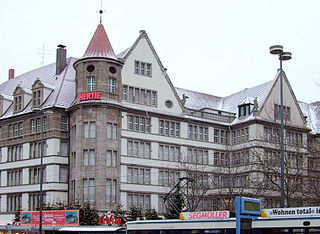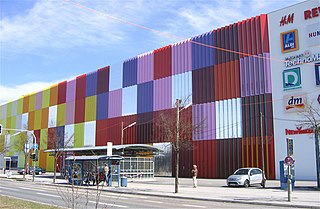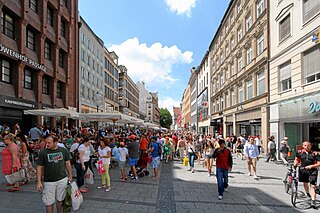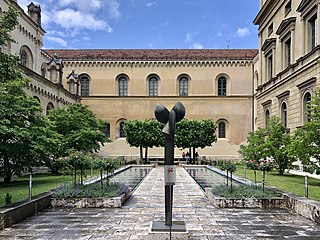
The Angerhof is a building in Munich that serves as a residential building, office building, hotel with restaurant, service location and parking garage. [1]

The Angerhof is a building in Munich that serves as a residential building, office building, hotel with restaurant, service location and parking garage. [1]
The location of the property is the street Oberanger near the Marienplatz and the Viktualienmarkt , between Munich's oldest monastery St. Anna and the new Jewish center on St-Jakobs-Platz. The nearest stops of the U-/S-Bahn are the Munich Marienplatz station and the subway station Sendlinger Tor.
The Angerhof combines, in its horizontal construction, the classic uses of traditional European townhouses for living, working and going out. On the ground floor there are retail stores and restaurants, in the floors above it are offices and in the fifth and sixth levels, on a total of 4,000 square meters, condominiums were created – with three-meter-high ceilings and roof terraces of up to 100 square meters. The interior architecture is reflected in its technically elaborate facade. Behind the sand-colored terracotta façade, light artist Ingo Maurer installed digitally programmed "façade glow" made up of energy-optimized LED lights. The Angerhof created a 1,000-square-meter inner courtyard for the public that opens directly onto the newly created pedestrian zone on the lower Anger. [2]
Construction began in 2005 according to the plans of architects Otto Steidle and Johann Spengler. The topping out ceremony took place in 2007 and the completion of the approx. 38,000 square meter floor spaced property was in 2009. The total construction costs amounted to approx. 150 million Euros. [3]
The place where the Angerhof stands today, was known for a long time in the post-war period as an "urban lumber pile". A post-war car park made of raw concrete with a gas station blocked the development plans of city construction advocate Christiane Thalgott for a long time. Lord Mayor Christian Ude (SPD) had not expected an urban construction before 2037, since that was how long the leasehold guaranteed of the parking garage existed. A solution was found when the Wöhr + Bauer GmbH managing director Wolfgang Roeck made the suggestion at the turn of the millennium to place the parking garage at the same place in an underground car park. [1] [4] Following the architectural competition for the Angerhof, the planning for the "Boulangerie Oberanger" followed from July to December 2003 - together by the construction department, planning department, district committee (BA) and the builder of the Angerhof, Wöhr + Bauer. On 17 February 2004, the BA, headed by Wolfgang Püschel, decided on the design from "real green" landscape architects. In May 2005, the city council approved the overall concept.
Angerhof Munich was nominated for the "MIPIM-Award" 2009 in the category "Business Center" on 12 March 2009, at the international real estate fair MIPIM in Cannes as one of only three buildings.

Munich International Airport- Franz Josef Strauß is an international airport serving Munich and Upper Bavaria. It is the second-busiest airport in Germany in terms of passenger traffic after Frankfurt Airport, and the ninth-busiest airport in Europe, handling 47.9 million passengers in 2019. It is the world's 15th-busiest airport in terms of international passenger traffic, and was the 38th-busiest airport worldwide in 2018. It serves as hub for Lufthansa including its subsidiaries Lufthansa CityLine, Air Dolomiti and Eurowings as well as a base for Condor and TUI fly Deutschland.

Allianz Arena is a football stadium in Munich, Bavaria, Germany with a 70,000 seating capacity for international matches and 75,000 for domestic matches. Widely known for its exterior of inflated ETFE plastic panels, it is the first stadium in the world with a full colour changing exterior. Located at 25 Werner-Heisenberg-Allee at the northern edge of Munich's Schwabing-Freimann borough on the Fröttmaning Heath, it is the second-largest arena in Germany behind Westfalenstadion in Dortmund.

The New Town Hall is a town hall at the northern part of Marienplatz in Munich, Bavaria, Germany. It hosts the city government including the city council, offices of the mayors and a small portion of the administration. In 1874 the municipality had left the Old Town Hall for its new domicile.

The Hochhaus Süddeutscher Verlag in the quarter of Berg am Laim in Munich serves as headquarters of the Süddeutscher Verlag which publishes the Süddeutsche Zeitung.

The Shopping mall Fünf Höfe in the center of Munich was created from 1998 to 2003 after the coring of a HypoVereinsbank building complex. In 2004, the Fünf Höfe was sold to DIFA and since then the official name has been CityQuartier Fünf Höfe.

The Karstadt München Bahnhofplatz is a department store of the Karstadt Warenhaus GmbH located in Maxvorstadt, Munich.
Allmann Sattler Wappner Architekten is a German architecture firm based in Munich. Established in 1987, it has existed in its current form since 1993. In 1997, Allmann Sattler Wappner Architekten received the German Architecture Award. Among many other buildings they had designed the Dornier Museum in Friedrichshafen, the Herz Jesu Church and the Haus der Gegenwart in Munich. According to the firm they currently employ 100 members of staff.

The Seven is a real estate project in the Munich Gärtnerplatz district, City area Ludwigsvorstadt-Isarvorstadt. In a former heating plant of the city of Munich, luxury properties were built.

The Mira is a district and shopping center that opened in 2008 in the Munich district Nordhaide at Schleißheimer Straße which borders the municipalities of Milbertshofen-Am Hart and Feldmoching-Hasenbergl.

Sendlinger Straße is an important shopping street in Munich's city center. It extends into the Munich old town in the south-east-northeast direction from the Sendlinger Tor in the west to the point where Fürstenfelder Straße and the Rindermarkt meet in the east. In July 2016, the conversion from a one-way street into a pedestrian zone was attempted.

The Hofstatt is a shopping mall that opened in 2013 in Munich's old town. The core of the building is the former site of the Süddeutscher Verlag, whose historical edifices are part of the design by architect Max Littmann on the Sendlinger Straße and the brick printing press building was also incorporated into the project.

The Fischbrunnen is a fountain in the center of Munich, whose history can be traced back to the Middle Ages. In 1954, Josef Henselmann created the fountain in its present form, using parts of Konrad Knoll’s neo-gothic fountain that was destroyed during the Second World War.
The Feilitzschstraße is a roughly 450-meter-long street in Munich's Schwabing district. After the incorporation of Schwabing to Munich in 1891, it was renamed after the Bavarian State Interior Minister, Maximilian von Feilitzsch (1834–1913) in order to avoid confusion with the Maffeistraße in the old town.

The Kaufingerstraße is one of the oldest streets in Munich and, together with the Neuhauser Straße, one of the most important shopping streets in Munich.

The Müllerstraße is a 700 meter long street in the Munich Glockenbachviertel.

The Kabinettsgarten is a small courtyard on the eastern side of the royal residence in Munich. The Kabinettsgarten adjoins the Allerheiligen-Hofkirche.

The Munich Old Town is part of the Bavarian capital Munich and has belonged to the city the longest, even if some places which are meanwhile districts of Munich, were mentioned long before Munich's documents spoke of the Old Town. The Old Town forms together with the district Lehel, the municipality No. 1 Altstadt-Lehel. The entire area of the Old Town is listed as both a historical ensemble as well as a historical monument listed in the Bavarian historical monument list.

Leonrodplatz is a square in the Munich district of Neuhausen. It was named in 1927 after the former Bavarian Minister of Justice Leopold von Leonrod.

The Walter-Sedlmayr-Platz is a square in Munich-Feldmoching. It is located west of the train station München-Feldmoching.

The Chinese Tower is a 25-metre wooden building resembling a pagoda at the Englischer Garten in Munich, Germany. The building was constructed from 1789 to 1790 and was opened to the public as an observation deck during the opening of the Englischer Garten in 1792. The tower burned down during the bombing of Munich during World War II and was reopened as a reconstruction in 1952. Today the tower is considered a landmark of the Englischer Garten.